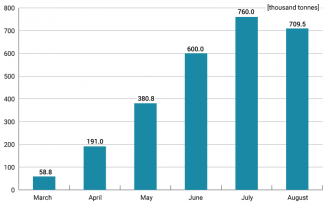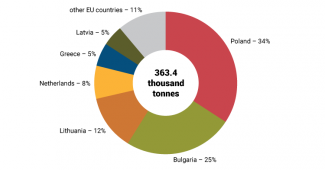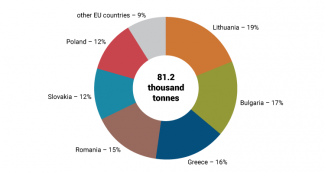Ukraine: stabilisation on the fuels market
On 21 September the Verkhovna Rada adopted a law which reinstated excise on fuels – 100 euros for 1,000 litres of petrol and diesel and 52 euros for 1,000 litres of LPG. Purchases made by the Ministry of Defence during martial law (no later than until 1 July 2023) were exempted from excise tax. According to government estimates, the excise will increase budget revenues by a maximum of UAH 3 billion monthly (approximately US$ 82 million).
The reinstatement of the excise has occurred in the context of the stabilisation of the Ukrainian fuels market observed over recent weeks. Imports of fuels rose from nearly 60,000 tonnes in March to 709,500 tonnes in August (see Chart 1). As much as 95% of petrol and 72% of diesel are sourced from EU countries. The main diesel suppliers are Poland, Bulgaria and Lithuania (see Chart 2) and the major petrol suppliers are Lithuania, Bulgaria, Greece and Romania (see Chart 3). Even though imports are not as high as before the war (in 2021 Ukraine imported an average of 865,000 tonnes of petrol, diesel and LPG monthly), this amount is sufficient due to decreased consumption caused by Russia’s invasion of Ukraine. The Ukrainian Ministry of the Economy estimates fuel consumption between September and December 2022 at 500,000-550,000 tonnes a month.
Commentary
- Kyiv’s stabilisation of the fuels market is a great success. Before the war Ukraine covered only approximately 50% of its demand for petrol, 15% for diesel and 20% for LPG by itself. In 2021 as much as 71% of the fuel was sourced from Russia and Belarus. However, following Russia’s invasion of Ukraine these supplies were completely halted. The EU supplied only 19% of all fuel imports, and over a half of it came from Lithuania (from the Mazeikiai refinery). The imports from Lithuania were transited through Belarus and the country stopped the transit several weeks before the war began. Furthermore, after 24 February Ukrainian ports were blocked and this made it impossible to transport fuel supplies in tankers. The situation was further compounded by the destruction of the only operating refinery in Kremenchuk and large-scale missile attacks on fuel storage facilities across the country. All this has led to fuel shortages, in particular for individual consumption, and resulted in huge queues at petrol stations and rationing.
- The situation began to stabilise between June and July due to the redirection of all available means of transportation to service fuels imports from EU countries. This was made possible as difficulties at the EU-Ukrainian border were overcome, including the different rail gauge, which significantly hampered logistics. Furthermore, priority was granted to vehicles crossing the border and transporting fuels to Ukraine. Due to measures undertaken from the end of June to mid-September, fuel prices fell by up to 20%, depending on the kind of fuel, despite the inflation rate topping 20% and the depreciation of hryvnia. The rationing of fuels was also phased out.
- On 15 March the Verkhovna Rada voted to eliminate excise in order to mitigate increases in fuel prices both for individual consumers and companies. This initiative was controversial since prices continued to grow (due to fuel shortages, not the excise) and the government lost one of its important sources of revenues. The decision to maintain a zero per cent excise rate on fuels for the army may cause fears that it could be used in the illegal trade in tax-free goods. It should be noted that the adopted excise rate is relatively low compared to other countries. In line with EU directives, excise cannot be lower than 359 euros for 1,000 litres of petrol and 330 euros for 1,000 litres of diesel. The excise imposed in Ukraine is also lower than before the war (139.5 euros for 1,000 litres of diesel and 213.5 euros for 1,000 litres of petrol). Only the excise rate for LPG has returned to its pre-war rate. According to estimates from the Ukrainian Ministry of the Economy, fuel prices at petrol stations should not increase despite the reinstatement of the tax since oil prices on the global oil markets have been falling.
- Given the government’s estimates regarding fuel consumption, it may be expected that in recent months fuel imports will be limited to approximately 600,000 tonnes a month. Most likely the limitations will be maintained until spring when the agricultural season begins or until a possible ceasefire is reached as this could bring in an economic recovery and, in consequence, an increase in fuel consumption.
Chart 1. Fuel imports to Ukraine since the outbreak of the war in February 2022

Source: Ukraine’s Ministry of the Economy.
Chart 2. The structure of diesel imports to Ukraine from EU countries in July 2022

Source: Eurostat.
Chart 3. The structure of petrol imports to Ukraine from EU countries in July 2022

Source: Eurostat.





